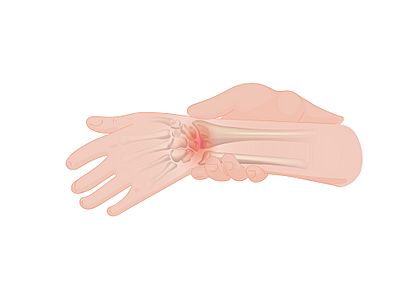Pain facts for kids
Quick facts for kids Pain |
|
|---|---|
 |
|
| An illustration of wrist pain | |
| Symptoms | Unpleasant sensory and emotional sensations |
| Duration | Typically depends on the cause |
| Types | Physical, psychological, psychogenic |
| Medication | Analgesic |
Pain is an uncomfortable feeling. It often happens when something strong or harmful affects your body. The International Association for the Study of Pain says pain is an "unpleasant feeling and emotion." It's linked to actual or possible damage to your body.
Pain helps us stay safe. It makes us pull away from things that hurt. It also helps us protect a body part that is healing. This way, we learn to avoid similar hurts in the future. Most pain goes away when the harmful thing is gone. It also stops when the body has healed. But sometimes, pain can last even after the body seems fine. Sometimes, pain can even appear when there's no clear cause.
Pain is a very common reason people visit a doctor. It is a main sign of many health problems. Pain can make it hard to focus or remember things. It can also make people feel grumpy, sad, or worried.
Simple pain medicines can help many people. Other things can also affect how much pain you feel. These include support from friends and family. Learning coping skills or being distracted can also help.
Contents
What Does the Word "Pain" Mean?
The word pain first appeared in English around 1297. It comes from the Old French word peine. This word came from the Latin word poena. Poena meant "punishment" or "penalty." In later Latin, it also meant "torment" or "suffering." The Latin word came from the Greek word poine. This Greek word generally meant "price paid" or "punishment."
How Do Doctors Describe Pain?
The International Association for the Study of Pain suggests ways to describe a person's pain. This helps doctors understand it better. They look at these things:
- The part of the body that hurts (like the stomach or legs).
- The body system that might be causing the pain (like nerves or digestion).
- How long the pain lasts and how often it happens.
- How strong the pain is.
- What caused the pain.
Short-Term Pain vs. Long-Term Pain
Pain usually lasts for a short time. It stops when the harmful thing is removed. Or it stops when the body heals. But some types of pain can last for years. Examples include rheumatoid arthritis or cancer pain.
Pain that lasts a long time is called chronic or persistent pain. Pain that goes away quickly is called acute pain. Doctors often use time limits to tell them apart. For example, pain lasting less than 30 days might be acute. Pain lasting more than six months might be chronic. Some say chronic pain is pain that lasts longer than expected healing time. Chronic pain can be linked to cancer or not.
How Doctors Help with Pain
Doctors can treat pain in many ways. The best way depends on the situation. Treating chronic pain can be tricky. It often needs a team of experts. This team might include doctors, pharmacists, and psychologists. It can also include physical therapists and nurses.
Sometimes, pain is not treated well enough. This can happen in hospitals or emergency rooms. It can also happen with long-term pain or cancer pain. This problem affects people of all ages. It includes babies and older adults. In some places, certain groups of people might get less pain relief. For example, women's pain is sometimes treated less than men's.
Many experts believe that getting pain relief is a human right. They also think that chronic pain should be seen as its own disease. They want pain medicine to be a full medical specialty. For now, it's a special area under other fields. These include anesthesiology and neurology. In 2011, Human Rights Watch said that many people still can't get simple medicines for strong pain.
Medicines for Pain
Doctors often use medicines called analgesics to treat sudden pain. Caffeine added to pain medicines like ibuprofen can sometimes help more. Ketamine can be used for short-term pain instead of some other strong medicines.
Sugar can help reduce pain in newborn babies. For example, during a heel prick for a blood test. Sweet liquid can also help babies aged one to twelve months. It can make them cry less after a shot.
Do Animals Feel Pain?
Some thinkers in the past, like René Descartes, believed animals did not feel pain like humans. But today, we know more. A scientist named Bernard Rollin helped write laws about pain relief for animals in the U.S. He said that even in the 1980s, researchers weren't sure if animals felt pain. Vets trained before 1989 were often taught to ignore animal pain.
Experts now believe that all animals with backbones (vertebrates) can feel pain. Some animals without backbones, like the octopus, might also feel pain. We can't ask animals if they hurt. But we can guess they do by how they act. For example, a rodent might pull its paw away from something sharp.
What about plants? Plants are living things. They can sense and react to touch or damage. But they do not feel pain. This is because they don't have pain sensors, nerves, or a brain. They don't have consciousness. Plants can react to sunlight, gravity, wind, and insect bites. But they don't have a nervous system like animals. Animals feel pain, which helps them survive. Plants' survival is shaped by life and death, not by suffering.
See Also
 In Spanish: Dolor para niños
In Spanish: Dolor para niños
- Feeling, how we experience things consciously
- Hedonic adaptation, how we get used to good or bad things
- Pain (philosophy), thinking about pain and suffering
- Pain and suffering, a legal term for stress from an injury

